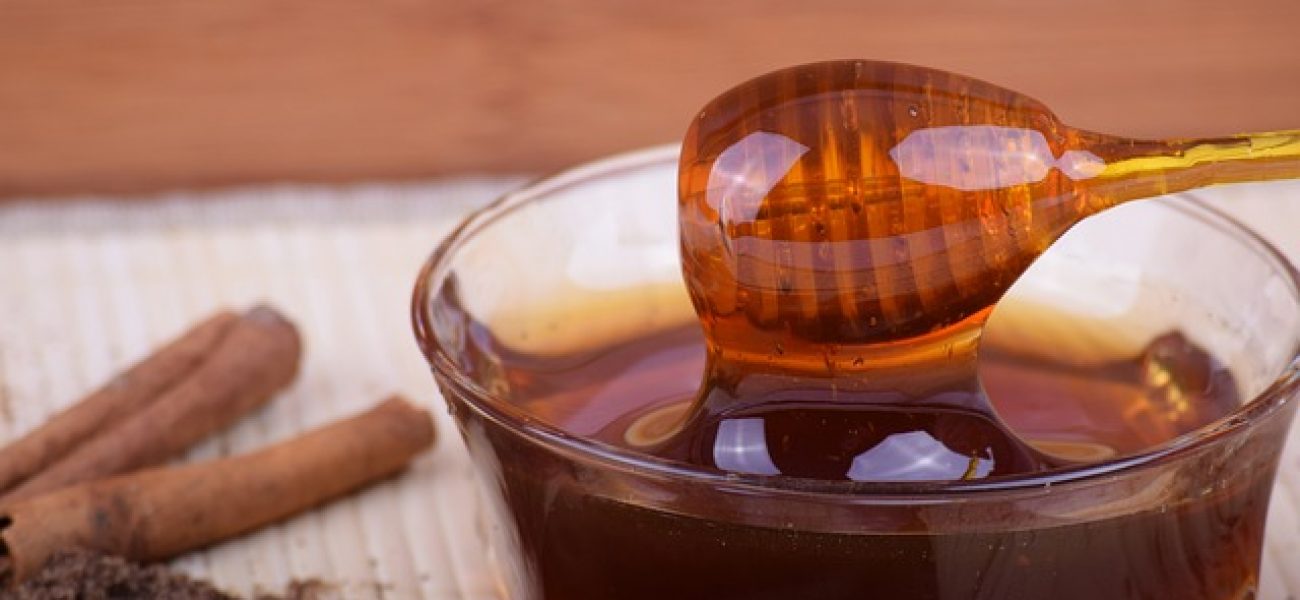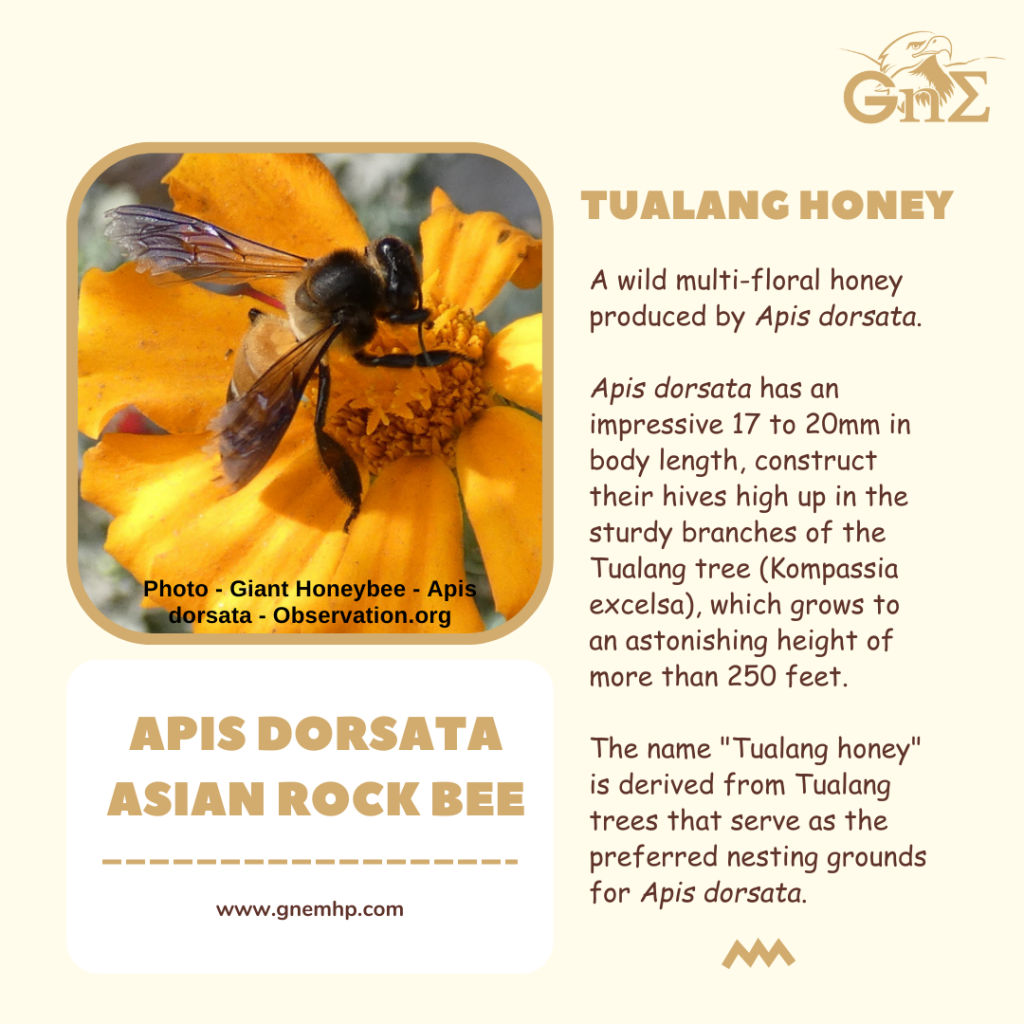
Tualang Honey:
Tualang honey is a wild multi-floral honey, meticulously produced by the stinging bee Apis dorsata, commonly known as the rock bee. These magnificent creatures, measuring an impressive 17 to 20mm in body length, construct their hives high up in the sturdy branches of the Tualang tree, scientifically referred to as Kompassia excelsa. The name “Tualang honey” pays homage to the towering Tualang trees that serve as the preferred nesting grounds for these remarkable bees.
The honeycombs created by these rock bees span up to an astonishing 6 feet in diameter and house an impressive population of approximately 30,000 bees. It is believed that the bees choose these lofty heights to safeguard their hives from potential disturbances caused by both humans and animals.
The honey hunters harvest honey from the hives of Apis dorsata, nested in a Tualang tree in the deep forest. They harvest the honey in the middle of the night, with traditional apparatus including a bamboo ladder, a cow-bone knife, and a container. This activity is consider risky and life-threatening as Apis dorsata is a venomous stinging bee and the honey hives hang on extremely high Tualang tree.
Apis dorsata diligently collects nectar from a diverse array of plants and blossoms found within the lush tropical rainforests of the West Coast of Peninsular Malaysia, hence the honey has a richer and complex taste (bitter-sweet), and there is research that has found it has higher phenolic content compared to monofloral honey.
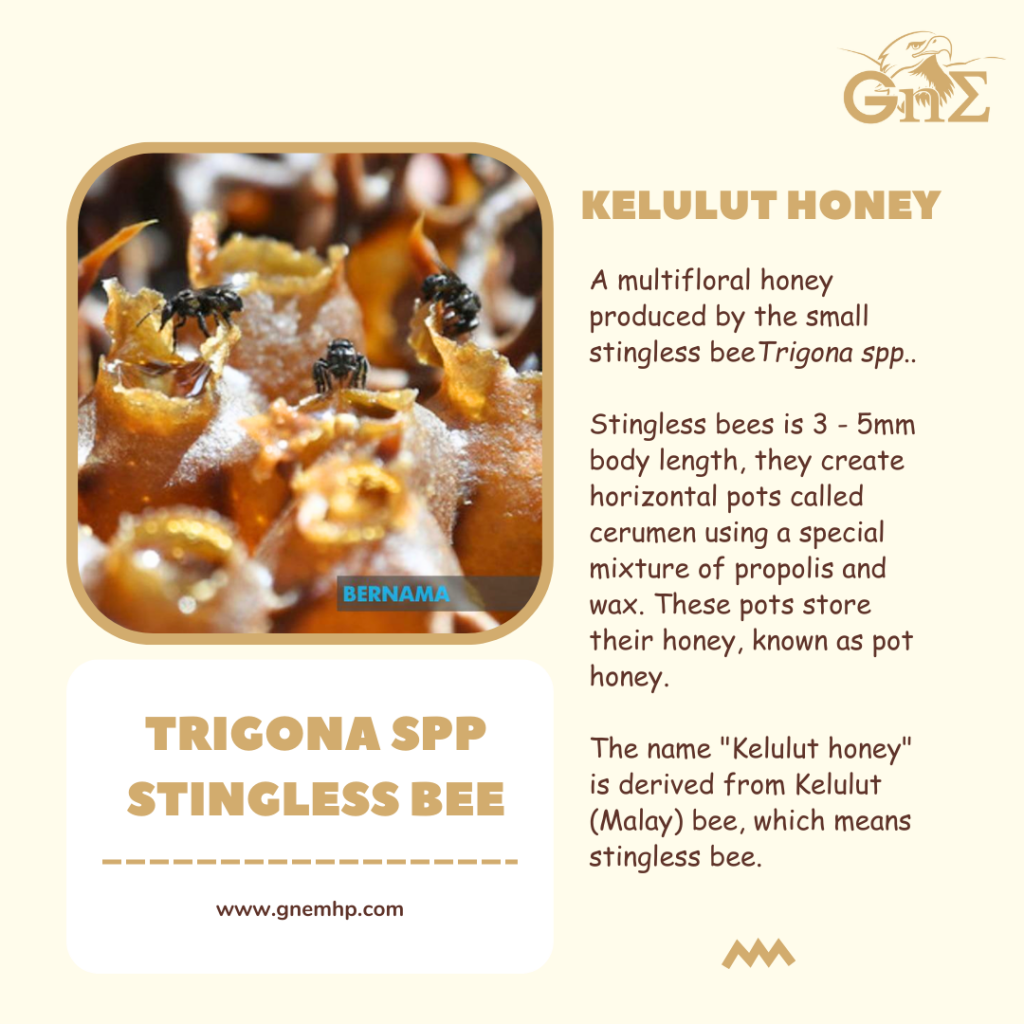
Kelulut honey:
Kelulut honey is derived from Trigona spp., a species of stingless bee that collects nectar from various polyfloral sources. These bees, commonly known as kelulut bees, are predominantly found in Malaysia, where the Heterotrigona itama and Geniotrigona thoracica species are most common species.
Unlike the larger Apis spp., the stingless honeybee (Meliponines) boasts a diminutive body size, measuring only 3 to 5mm in length. These bees thrive in tropical countries such as Malaysia, Indonesia, Thailand, and Brunei.
In recent years, kelulut beekeeping has emerged as a burgeoning industry. Stingless bees construct horizontal pots using a unique blend of propolis and wax known as cerumen. These pots serve as storage vessels for the honey they produce, aptly named pot honey. However, stingless bees often produce a low honey yield compared to the Apis species. Also, kelulut honey offers a distinctive taste experience, distinguished by its slightly sour taste and more fluid consistency.
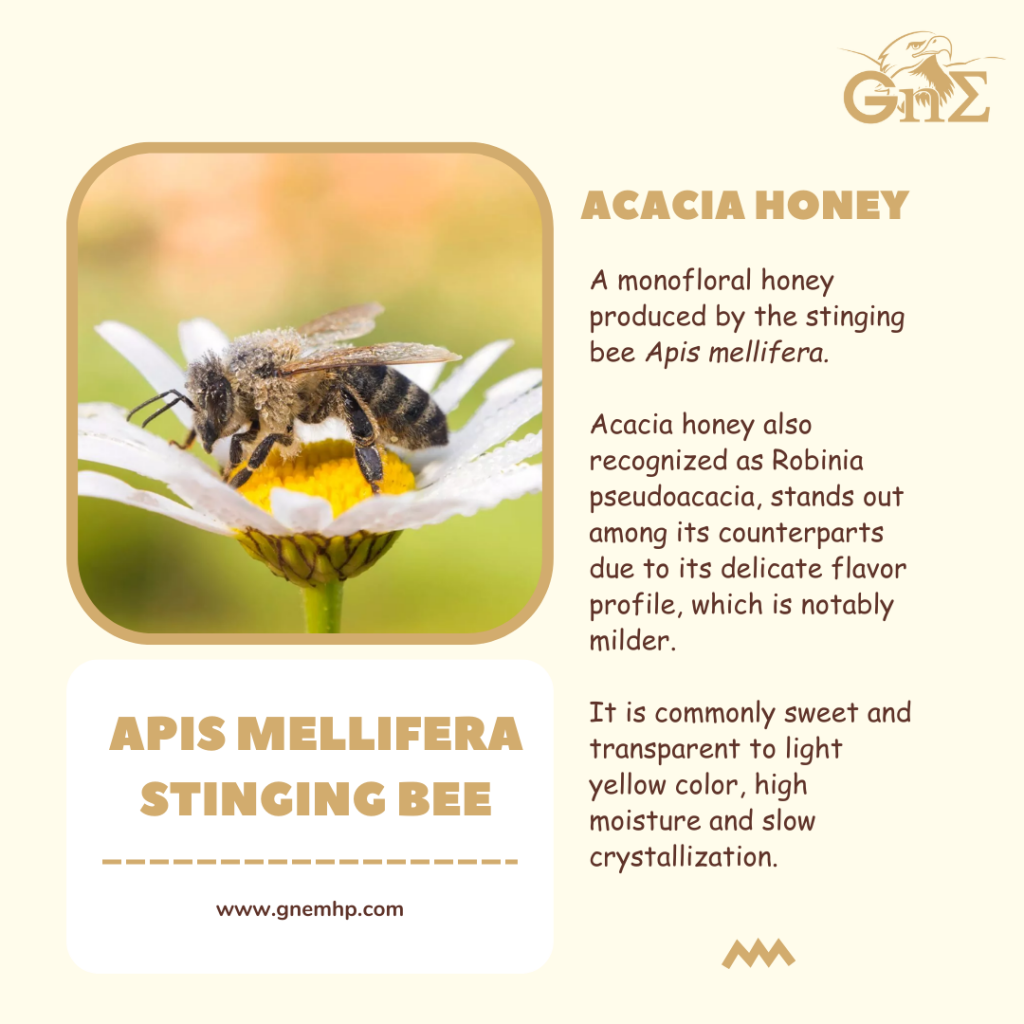
Acacia honey:
Acacia honey is produced by the stinging bee Apis mellifera, also a cultured bee species that expertly collects the extrafloral nectar from the Acacia mangium trees.
Apis mellifera, commonly referred to as the Stinging honeybee or Western honeybee, possesses a moderate body size, measuring approximately 12mm in length.
In modern beekeeping, Apis mellifera honeybees are raised in wooden boxes with brood chambers. The frames in the brood chambers allow the honeybees construct hexagonal-shaped combs using wax, creating a unique honeycomb which contain honey.
Acacia honey, also recognized as Robinia pseudoacacia, stands out among its counterparts due to its delicate flavor profile, which is notably milder. Moreover, this exquisite honey exhibits a captivating transparent to light yellow hue, remaining free from crystallization.
Table of comparison:
Characteristics | TUALANG | KELULUT | ACACIA |
Types of honey | Wild polyfloral honey | Polyfloral honey | Monofloral honey |
Types of bee | Stinging bee Apis spp. (Apis dorsata) | Stingless bee Trigona spp (Heterotrigona itama and Geniotrigona thoracica) | Stinging bee Apis spp. (Apis mellifera) |
Specification of bee | Stinging honeybee (giant rock bee), 17 – 20mm body length. | Stingless honeybee (Meliponines), 3 – 5mm body length. | Stinging honeybee (Western honeybee), about 12mm body length. |
| Bee hives | Apis dorsata builds hives high up in the branches of Tualang tree (Kompassia excelsa), the honeycombs can be up to 6 feet across and can contain as many as 30,000 bees. | Stingless bees build horizontal pots using a mixture of propolis and wax called cerumen. These pots are used to store honey, and the honey produced is referred to as pot honey. | Apis Mellifera honeybees build hexagonal-shaped combs with wax in the nests and the honey produced is known as comb honey. |
Honey Characteristic | Tualang honey is a polyfloral honey with a richer and complex taste (bitter-sweet), and there is research that has found it has higher phenolic content compared to monofloral honey. The moisture content is lower than stingless bee honey, tend to crystalize overtime. | Kelulut honey is a polyfloral honey has a richer and slightly sour taste, and there is research that has found it has higher phenolic content compared to monofloral honey. The moisture content is higher than stinging bee honey, hence it might have a shorter shelf-life. | Acacia honey is a monofloral honey that has a sweet scent, milder taste and possesses certain characteristics of its floral source. This honey has transparent to light yellow color and normally not easily crystallized. |
Which one is the best?
All of the above honey is a natural sweetener that offers various health benefits. Honey has anti-inflammatory, heart-protective, and antioxidant effects. These benefits are due to the presence of flavonoids, phenolic acids, organic acids, and volatile compounds present in the honey. Additional processing such as heating and pasteurization could destroy or reduce certain nutrients in the honey, hence, it is advisable to choose raw or unprocessed honey that undergoes minimal processing, such as straining and bottling only, without heating and pasteurization. Raw and unprocessed honey may retain the nutrients and natural components of honey, including bee propolis, pollen, beeswax, enzymes, and more.
Also, honey can come in various colors ranging from clear and colorless like water to yellow, dark amber or black. The color variation can be attributed to the floral source, color intensity, different seasons of collection, and storage conditions. Studies also found that the color intensity is a reliable indicator for selecting honey with a stronger antioxidant capability. A darker-colored honey often exhibits higher antioxidant activity and higher total phenolic content. Hence, if you wish to gain health benefits from honey instead of using it as a sweetener, dark-colored honey will be more preferred.
2 Hints to Choose High-Quality Honey:
1. Choose Raw or Unprocessed Honey: This type of honey retains nutrients and natural compounds that may provide anti-inflammatory and antioxidant effects.
2. Choose Dark-Colored Honey for More Health Benefits: Dark-colored honey exhibits higher antioxidant activity and total phenolic content, meaning it may have stronger antioxidant and anti-inflammatory effects.
However, the most important tip is to follow your preferences. Most raw and unprocessed honey tends to crystallize over time, but don’t worry, the crystalized honey is not a sign of spoilage and is still safe to consume. Additionally, honey has a rich taste that is not only sweet; the organic acids and volatile compounds contribute to its sour and bitter notes, as well as its color and aroma.
Gold-G® Health Food Series
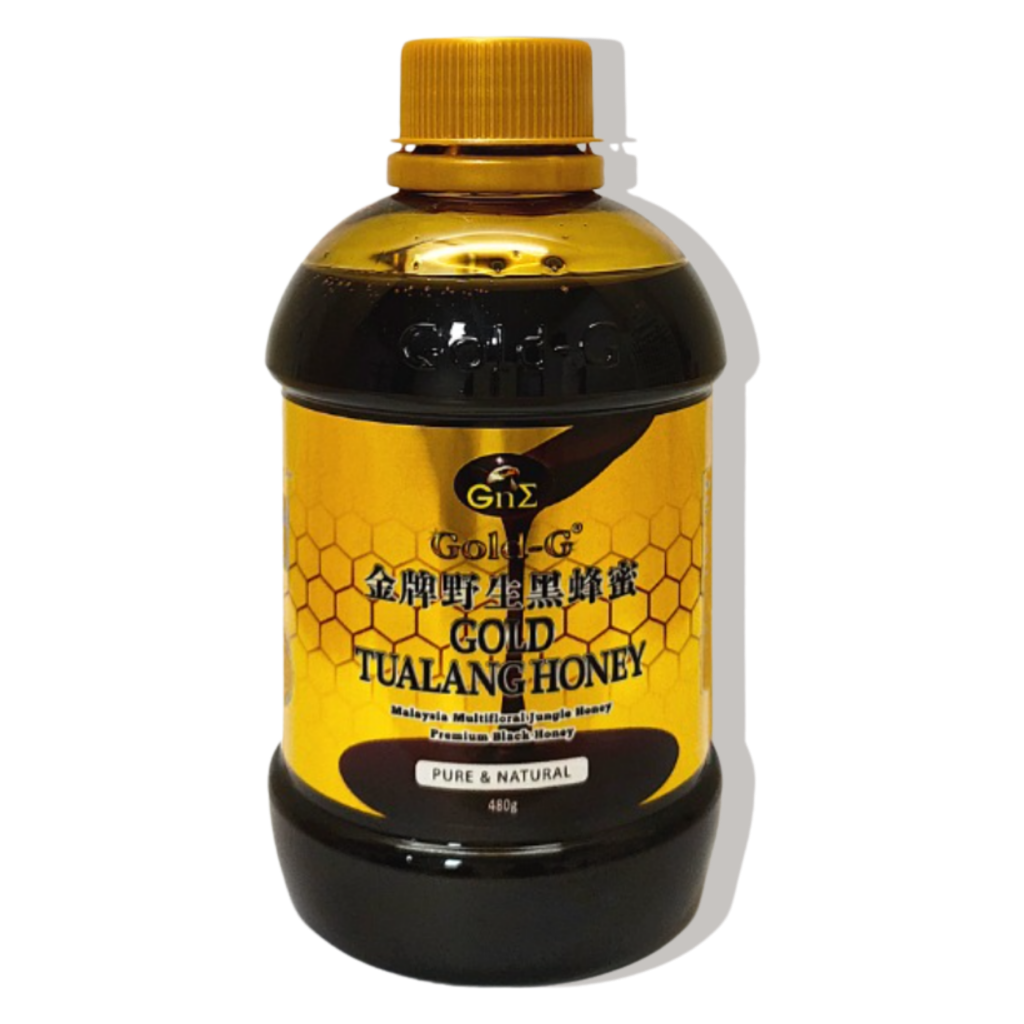
Gold-G® Gold Tualang Honey is a raw and natural honey produced by the Asian Rock Bee, Apis dorsata. It is 100% pure and undergoes minimal processing, with only straining to remove larger particles such as bees, leaves, and honeycomb flakes. It is then directly bottled in a GMP certified factory, allowing it to retain its natural friendly bacteria, propolis, pollen grains, phytonutrients, phenolic acids, and flavonoids. In addition to its natural taste and aroma, it offers higher nutritional value and stronger therapeutic effects compared to processed honey!
Click the link below for direct purchase.
References:
- Mohd Kamal, D. A., Ibrahim, S. F., Kamal, H., Kashim, M. I. A. M., & Mokhtar, M. H. (2021). Physicochemical and Medicinal Properties of Tualang, Gelam and Kelulut Honeys: A Comprehensive Review. Nutrients, 13(1), 197. https://doi.org/10.3390/nu13010197 Nutrients | Free Full-Text | Physicochemical and Medicinal Properties of Tualang, Gelam and Kelulut Honeys: A Comprehensive Review (mdpi.com)
- Kek, S.P.; Chin, N.L.; Yusof, Y.A.; Tan, S.W.; Chua, L.S. Classification of entomological origin of honey based on its physicochemical and antioxidant properties. J. Food Prop. 2017, 20, S2723–S2738. https://www.tandfonline.com/doi/full/10.1080/10942912.2017.1359185
- Zae, T.; Azlan, A.; Sajak, A.A.B.; Hock, E.; Chin, N.L.; Noh, M.M.; Khalid, N.M. Comparison of selected local honey with Manuka honey based on their nutritional and antioxidant properties. Food Res. 2020, 4, 205–213. https://www.myfoodresearch.com/uploads/8/4/8/5/84855864/_26__fr-2019-s12_zae.pdf
- Khalil, Md & Mohamed, Mahaneem & Jamalullail, SMS & Alam, Nadia & Sulaiman, Siti Amrah. (2011). Evaluation of radical scavenging activity and colour intensity of nine Malaysian honeys of different origin. Phenolic acid composition and antioxidant properties of Malaysian honeys. J ApiProduct ApiMedical Sci. 3. 04-11. 10.3896/IBRA.4.03.1.02.https://ibra.org.uk/wp-content/JAAS/VOL3/3-1/JAAS%203%201%2002L.pdf
- Moniruzzaman, M., Khalil, M. I., Sulaiman, S. A., & Gan, S. H. (2013). Physicochemical and antioxidant properties of Malaysian honeys produced by Apis cerana, Apis dorsata and Apis mellifera. BMC complementary and alternative medicine, 13, 43. https://doi.org/10.1186/1472-6882-13-43 https://bmccomplementmedtherapies.biomedcentral.com/articles/10.1186/1472-6882-13-43
- Wan Ismail, Wan Iryani. (2016). A review on beekeeping in Malaysia: History, importance and future directions. 11. 70-80. https://www.researchgate.net/publication/316546344_A_review_on_beekeeping_in_Malaysia_History_importance_and_future_directions

